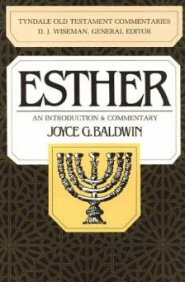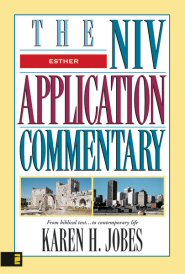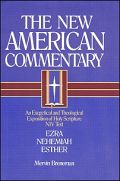Best Resources on Esther
The book of Esther shows us that God is present even when he seems distant. In the course of the story, Esther—a Jew living during the time of the exile—becomes the queen of Persia. However, an official named Haman plots to kill the Jews throughout the empire. Esther and Mordecai, her cousin, expose the attempted genocide. Mordecai’s cunning, Esther’s bravery, and God’s unseen hand unite to save the Jewish exiles from destruction.
—Faithlife Study Bible, Lexham Press
Everything You Need to Study & Teach Esther
Expository Preaching Kits are curated resources all focused on helping you teach a single book of the Bible—keeping you prepared without weighing you down.
Best Commentaries on Esther
Frederic Bush, Word Biblical Commentary (WBC), Thomas Nelson, 1996, 528 pp.
Engage the challenging books of Ruth and Esther utilizing the dynamic expertise of Frederic Bush. Study the narratives of these books by drawing on Bush’s knowledge of ancient Near Eastern customs, languages, and Hebrew narrative and poetry to illuminate the meaning of these books and the development and transmission of each book’s textual witnesses. Organized for easy reference, Word Biblical commentaries make an ideal Bible study companion, whether you are studying a single passage or a complete biblical book.
- Level: Advanced
- Type: Technical
Joyce G. Baldwin, Tyndale Old Testament Commentaries (TOTC), InterVarsity Press, 1984, 126 pp.
The Jews were threatened with genocide. A decree ordered the extermination of young and old, women and children. The place: Persia. The time: fifth century BC. The book of Esther describes how this crisis was averted through the bravery of Esther, the wisdom of her stepfather, and the unity of the Jewish people. It also reveals the God who quietly—and sometimes unexpectedly—works behind the scenes to order the events of our lives. Joyce Baldwin draws out the beauty and power of this book by discussing its background, structure, and theology, and by providing a passage-by-passage analysis of its contents.
- Level: Basic
- Type: Devotional
Karen H. Jobes, NIV Application Commentary (NIVAC), Zondervan, 1999, 256 pp.
Queen Esther faced and helped avert the potential genocide of her people. She rose to the top of political power without any of the advantages of aristocratic birth, well-placed friends, inherited wealth, or social prestige. Yet the book of Esther’s real story is not found in political intrigue or superior management ideals. It is that God is at the center of it, despite the fact that God is not mentioned anywhere in the book. The great lesson to be learned is that God keeps his promises.
- Level: Intermediate
- Type: Devotional
Mervin Breneman, New American Commentary (NAC), B&H, 1993, 370 pp.
Mervin Breneman focuses on the intrinsic theological and exegetical concerns of Ezra and engages the range of issues raised in contemporary biblical scholarship.
- Level: Intermediate
- Type: Expository
Adele Berlin, JPS Bible Commentary (JPSTC), Jewish Publication Society, 2001, 110 pp.
This commentary approaches the book of Esther from a fresh literary point of view. It includes essays entitled “When and Where Was the Book of Esther Written?” “Sex and Spies,” “Rabbinic Interpretation,” and many others.
- Level: Intermediate
- Type: Technical
Best Books on Esther
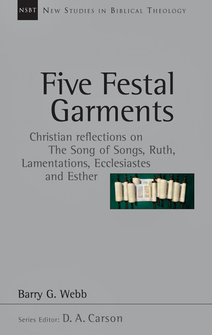
Five Festal Garments: Christian Reflections on the Song of Songs, Ruth, Lamentations, Ecclesiastes and Esther
These five Old Testament books, traditionally known simply as “the Scrolls,” are among the most neglected parts of the Christian Bible. In Judaism, the Song of Songs, Ruth, Lamentations, Ecclesiastes, and Esther were eventually adopted as lectionary readings for five of the major festivals. In Christian tradition, however, no consensus has emerged about their proper use. Each book presents particular difficulties regarding how it relates to the rest of Scripture and how it should be understood as the Word of God for us today.
Learn more
Books of Esther: Structure, Genre and Textual Integrity
Books of Esther applies form-critical tools to Esther’s Septuagint and non-Septuagint (“Lucianic”) Greek texts. Differences in vocabulary, content, and style show that the Greek books of Esther are independent traditions stemming from, and aimed at, two distinct religious communities. The “Lucianic” version appears more personal, orthodox, nationalistic, and Jewish. Its audience is Palestinian, and it intends to foster communal identity. The Septuagint version exudes a more matter-of-fact, reportorial, Hellenistic style, with an eye to tolerance of heretics and audience entertainment. The Masoretic version became canonized because it is the most multivalent of the Esthers, appealing to both religious and secular elements of Judaism.
Learn more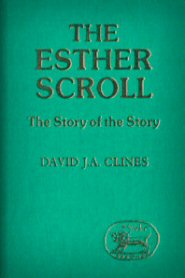
Esther Scroll: The Story of the Story
The book of Esther emerges from complex origins. According to David J. A. Clines, the story combines elements from numerous literary, textual, and storytelling traditions. Through the telling and retelling of the story, the book as it appears in the modern canon slowly emerges. In Esther Scroll, Clines uncovers this fascinating history by examining the book’s literary and textual elements, the story’s shape, and the shifts in meaning as new generations have retold the story and interpreted it for their own time.
Learn more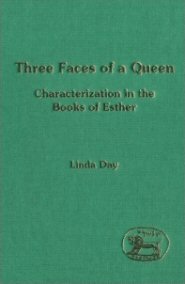
Three Faces of a Queen: Characterization in the Books of Esther
This original study offers, for the first time, an analysis of the characterization of Esther as she is portrayed in each of the three primary versions of the book of Esther—the Masoretic text, the Septuagint text, and the Greek text. This study of characterization has implications beyond itself. It permits a reassessment of relations between the book of Esther and other literature of the time; it sheds light on the place of origin of the ancient versions of Esther; and it raises serious feminist and canon-critical questions about the book’s role.
Learn more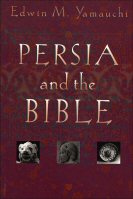
Persia and the Bible
Cyrus, Darius, and Xerxes—who were these Persian kings? Internationally noted historian Edwin Yamauchi uses the latest archaeological information from Iran, along with over 100 photos and maps, to paint an illuminating portrait of Persia’s people, kings, cities, and role in Old Testament history. An invaluable guide to traversing the books of Jeremiah, Ezekiel, Daniel, Esther, Ezra, and Nehemiah.
Learn moreBest Courses on Esther
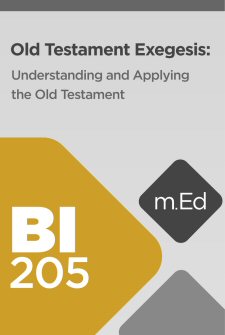
Mobile Ed: BI205 Old Testament Exegesis: Understanding and Applying the Old Testament (15 hour course)
Embark on a journey of Old Testament Hebrew exegesis with Jason DeRouchie. The books of the Old Testament were the only Scriptures Jesus had. It was books like Genesis, Deuteronomy, Isaiah, and Psalms that shaped Jesus’ upbringing and that guided his life in ministry as the Jewish Messiah. It was these Scriptures that Jesus identified as God’s Word and that he considered to be authoritative; it was these Scriptures he believed called people to know and believe in God and guarded them against doctrinal error and hell. This course will give you the tools you need to access meaning in the Old Testament, then apply it to your life. It will help you to grow in reading God’s living Word for depth and not just distance.
Learn more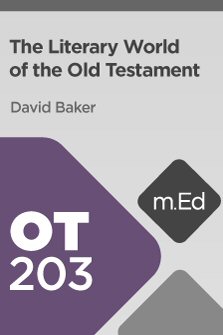
Mobile Ed: OT203 Literary World of the Old Testament (6 hour course)
Join David W. Baker on a whirlwind tour to explore the Old Testament from many different angles and how it relates to ancient Near Eastern literature. From creation accounts and stories of destruction to Wisdom Literature, discover different biblical literary genres that have parallels in ancient Near Eastern literature. Explore extrabiblical historical texts that mention key events and figures from the Old Testament. Understand how Israel fits into and is impacted by its ancient Near Eastern environment but also how it is separate and unique, mainly on a theological level, but also by its distinct worldview.
Learn more
Mobile Ed: OT204 Social World of the Old Testament (4 hour course)
In an age of international travel and migration, we’re familiar with people who look, sound, eat, and believe differently than we do. To become friends, it’s helpful to understand where they come from and how they do things differently, or the same, as we do. In the same way it is necessary to understand someone who comes from a different place than we do, how much more necessary is it to understand someone who is from not only a different geographical place but also a different time than we are? The Old Testament starts at the beginning of the world. This course will undertake the task of crossing the bridges of geography, climate, time, and a landscape unknown to us: ancient Israel. Throughout the course, David W. Baker will address aspects of life from our own culture and time, as well as family structure and societal systems from ancient Israelite life. As you learn more about the social world of the Old Testament, you will be struck not only by our differences but also our common humanity and that we share the same dreams, hopes, and fears as they did.
Learn more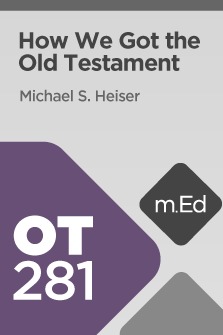
Mobile Ed: OT281 How We Got the Old Testament (5 hour course)
In this course, ancient-language expert Dr. Michael Heiser gives a thorough background of the Hebrew Bible’s writing, composition, canonicity, and transmission through the ages. This course also surveys text criticism—what are Hebrew scholars today doing with these ancient manuscripts? How does their work affect English translations of the Bible? By understanding criticism, your personal Bible study will be richer, even with little knowledge of the Hebrew language.
Learn more
